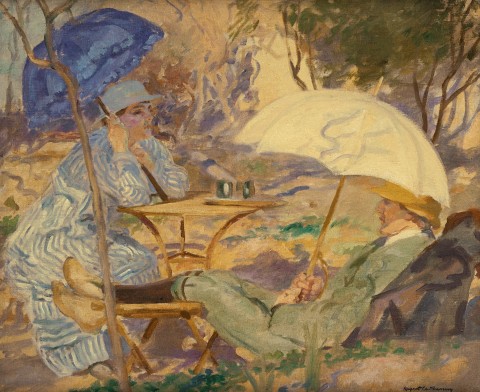FEBRUARY, CAVALAIRE, c.1910
RUPERT BUNNY
oil on canvas on composition board
50.0 x 61.0 cm
signed lower right: Rupert C W Bunny
inscribed on label verso: February (Cavalerie [sic.])
bears inscription on frame verso: ROBERT HAINES
Estate of the artist
Macquarie Galleries, Sydney
Mr F E Trigg, Sydney, acquired c.1950s
Thence by descent
Private collection, Sydney
Exhibition of Paintings by Rupert C. W. Bunny, Fine Art Society’s Gallery, Melbourne, 15 - 27 November 1922, cat. 34 (as ‘February Sun at Cavalaire’)
An Exhibition of Oil Paintings and Drawings by Rupert C. W. Bunny, Anthony Hordern and Sons Ltd Galleries, Sydney, 2 – 31 May 1923, cat. 34 (as ‘February Sun at Cavalaire’)
possibly: Exhibition of Paintings by Rupert Bunny, Macquarie Galleries, Sydney, 3 – 22 September, cat. 26 (as ‘Cavalaire’)
An exhibition of French Landscapes and a Group of Early Paintings by Rupert Bunny, Macquarie Galleries, Sydney, 1 – 8 October 1945, cat. 13 (as ‘February, Cavalaire’)
‘Sundry Shows’, The Bulletin, Sydney, vol. 43, no. 2232, 23 November 1922, p. 34 (as ‘February Sun at Cavalaire’)
‘Rupert Bunny. Modern French Art’, Sydney Morning Herald, Sydney, 2 May 1923, p. 14 (as ‘February Sun at Cavalaire’)
Turnbull, C., & Buesst, T., The Art of Rupert Bunny, Ure Smith Pty Ltd, Sydney, 1948, p. 71 (as ‘February, Cavalaire’)
Painted in the South of France during the years immediately following Rupert Bunny’s triumphant return to Australia in 1911, February, Cavalaire, c.1913 encapsulates well the ‘naturalness and sunny serenity’1 that embodied his work at this time – a precious ‘golden age’ before the ravages of The Great War would forever alter the cultural, political and social landscape of his beloved France. First sojourning in the picturesque seaside resort of Cavalaire-sur-Mer in the Provence/Côte d’Azur region during the winter of 1912 – 13, Bunny here completed two or three figure paintings including February, Cavalaire, and embarked upon his Symbolist-inspired mythological series. Also known as February Sun at Cavalaire, notably the present work and another image of Cavalaire were considered ‘audacious experiments’ when first exhibited in Melbourne at the Fine Art Society’s exhibition in November 1922, with the art critic for the Sydney Morning Herald remarking in particular upon the ‘shattering extravagance of Reckitt’s Blue’2 in February Sun at Cavalaire. Such comparison most certainly alluded to the tea dress worn by Madame Bunny here which not only evokes the ultramarine colour but also, the iconic striped pattern, of the famous laundry soap packaging, while the author’s comments regarding ‘the figure of the man [which] is confused and out of drawing’3 directly reference her male companion who is less distinguishable from the sun-dappled landscape in his khaki suit. Given his profile and attire which betray striking affinities to photographs of Bunny and especially, to his celebrated Self Portrait, 1920 (National Gallery of Victoria), indeed, it may be that the work depicts the artist with his beautiful wife and model, Jeanne-Heloise, enjoying an intimate moment of ‘dolce far niente’ in the gentle sunlight.
With their charm and sensuous beauty, Bunny’s lyrical explorations of the poetry in the everyday were, unsurprisingly, among his most favoured works by private collectors in Melbourne and Sydney which included such prominent figures as Hugo Meyer; Dr Samuel Ewing; and the Hon. Sir James McCay. Significantly, both February, Cavalaire and the previous lot, were originally owned by Mr F.E. Trigg who was a financial adviser to John Fairfax & Sons from 1945 – 60, and as such, would have known the Chairman, Warwick Fairfax, and longtime Managing Director, Rupert Henderson – both of whom were avid art collectors and renowned afficionados of Bunny’s art.
1. Eagle, M., The Art of Rupert Bunny in the Australian National Gallery, Australian National Gallery, Canberra, 1991, p. 101
2. Modern French Art’, Sydney Morning Herald, Sydney, 2 May 1923, p. 14
3. ibid.
VERONICA ANGELATOS
